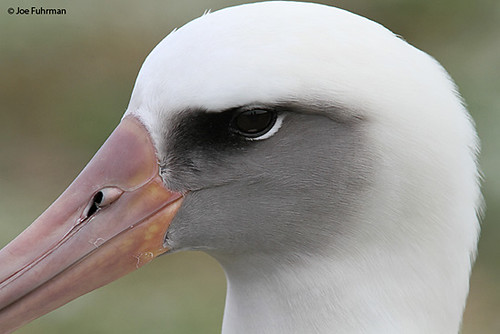tags: Laysan Albatross, Phoebastria immutabilis, Diomedea immutabilis, birds, mystery bird, bird ID quiz
[Mystery bird] Laysan Albatross, Phoebastria (Diomedea) immutabilis, photographed on Midway Atoll National Wildlife Refuge, Midway Island, Hawai'i. [I will identify this bird for you in 48 hours]
Image: Joe Fuhrman, March 2010 [larger view].
NOTE: Unless you are a beginning bird watcher, PLEASE wait 24 hours before identifying this bird. (Intermediate-expert birders are encouraged to use puns, anagrams, poetry references or citations, Monty Python quotes or anything else that tickles your fancy to indicate you've identified this species during the first 24 hours after the image pops up. Thank you.) Everyone -- even beginning birders! -- PLEASE name at least one field mark that supports your identification.


Monty Python quotes regarding the bird's flavour would be appropriate here.
I wouldn't even call myself a beginner birder, but I'll still hold back on identifying this one because it's rather obvious (the picture's location is a big hint) and I'll let others have a go.
It's a C-47! (boy am I old!) I agree on Monty python, but Sam Coleridge wants to claim prior credit.
As to species, that is unchangeable, based on the beak color, location of the nares, and dark feathers before the eye.
But sometimes IDs like this make me more complaysant than I should really be.
That's a STUNNING picture! Really amazing. I love the "eyeliner" effect of the white below the eye, too.
I saw a related species (I think), but wavy, when I visited the Galapagos. And in my ornithology class, we learned a little about their special wing joints that they could hold open with little effort to soar. Oh, and dynamic soaring!
If you put a P before unchangeable, is that a good pun?
Anyway, I go with Punchangeable. Fieldmarks: really cool, big shades. Even cooler close to the eye.
With shots like this, sometimes it's a worthwhile exercise to ignore the location data, and see if you can still state with certainty what the bird is. After all, if this guy showed up in, say, Florida, the location wouldn't really help.
That's an interesting challenge, psweet.
Looking at this closeup, the nares are key; they're set forward in the beak, compared to most birds. They take us quickly to the tubenoses (that's what Cornell's site calls them). From there we have four groups, two petrel groups, albatrosses, and a group including sheerwaters and petrels. At that point, the size of this bird indicates albatross. The browridge above the eye is also typical of albatrosses (but the others? I don't know.)
At that point, I'd have to sort through pictures, except I've seen pictures of the Laysan Albatross before, and since they're so utterly stunning, I managed to remember.
Hi, Bardiac, I went looking through my old seabird guide, and the only albatross that comes close is the Black-browed (Diomedea melanophris -- I'm aware that the genus name has changed, but I don't have anything recent to look at). Anything else either has a different face pattern or a dark bill. It looks like Black-billed should have a more orangey bill, rather than the pink color here, and it also looks like the dusky face pattern shouldn't extend behind the eye, as it does here.
One more point -- as Bardiac pointed out, the position (and structure, actually) of the nostrils puts this bird in the tubenoses (order Procellariformes). Turns out that within that order, only the Albatrosses have the tube around the nostrils buried within the bill. All of the shearwaters, petrels, etc. have the tubes entirely exposed on the top of the bill.
Psweet, that's really interesting. Now I'm going to try to find a closeup of a sheerwater or petrel nose :) Thanks!